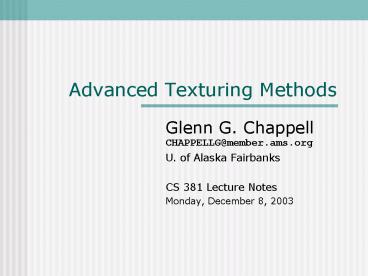Advanced Texturing Methods PowerPoint PPT Presentation
Title: Advanced Texturing Methods
1
Advanced Texturing Methods
- Glenn G. ChappellCHAPPELLG_at_member.ams.org
- U. of Alaska Fairbanks
- CS 381 Lecture Notes
- Monday, December 8, 2003
2
ReviewQuick Dirty Texture Generation
- An easy way to generate a small texture is to
begin with a string array, then turn map
characters into colors somehow. - For an example, see qdtexture.cpp, on the web
page.
3
ReviewProcedural Texture 1/6
- Often, the trickiest part of texture mapping is
generating the texture image. - Possible sources
- External images.
- From photographs, various graphics programs.
- Reading the frame buffer.
- Use glReadPixels.
- Program-generated texture.
- This is what we look at now.
- Texture generated from scratch by a program is
called procedural texture. - We look at a technique for procedural-texture
generation pioneered by Ken Perlin of New York
University.
4
ReviewProcedural Texture 2/6
- Perlins idea is to begin with a special noise
function. Properties - Easy to generate.
- Random-ish looking.
- All variation is at about the same scale.
- All variation has about the same amplitude.
- Highest, lowest, and average values are about the
same for all parts of the image.
5
ReviewProcedural Texture 3/6
- One type of noise we would like to be able to use
is 1/f-noise. - All frequencies present, with amplitudes
proportional to the inverse of the frequency. - So the height of a hill is proportional to its
width. - 1/f-noise is the way the real world looks.
- But its a pain to generate.
- Perlin suggests simulating 1/f-noise
- Sum many copies of his noise function, each at
twice the frequency and half the amplitude of the
previous.
6
ReviewProcedural Texture 4/6
- Another idea of Perlin noise with cusps.
- Sum as before, but take the absolute value of
each noise function before summing them all. - Good for cloudy-looking things.
7
ReviewProcedural Texture 5/6
- Perlins technique is aimed at 3-D textures.
- Here we can make objects appear to be cut out of
a 3-D block of material. - Essentially, let the texture coordinates be the
same as the vertex coordinates. - Unfortunately, OpenGL 1.1 (which most of us seem
to have) does not support 3-D texturing in a
system-independent manner. - However, we can use Perlins techniques to
generate 2-D texture simply by taking a slice of
a 3-D noise function.
8
ReviewProcedural Texture 6/6
- I have created a package (Pnoise) to create a
minor variation on Perlins noise function. - Major differences
- His is entirely deterministic. I use an
externally seeded pseudo-random number generator. - I produce noise functions that wrap.
- The images on the previous slides were generated
by my code, not Perlins. - Specifically pnoise3d(), fnoise3d(),
filterfnoise3d(, pnoise_abs). - See proctexture.cpp for sample code.
9
More on Procedural TextureProducing Colors 1/2
- One piece remains in order to produce interesting
procedural textures - Convert a noise function into an image.
- We need to be able to map noise values (in
1,1) to colors (RGB).
10
More on Procedural TextureProducing Colors 2/2
- One versatile method
- Choose colors for specified values in 1,1.
- Then determine the color associated with a value
by lirping between the two nearest specified
values. - EXAMPLE TIME.
1.0
0.7
0.2
1.0
1.0
0.7
0.2
1.0
0.7
11
More on Procedural TextureOther Methods
- Other methods for generating procedural texture
are possible (and are not really that difficult
to come up with). For example - A particle doing a random walk and leaving behind
trails of color. - This technique was used to generate some of the
3-D textures used in BLUIsculpt. - Think of something else
12
Bump Mapping Demo
- Bump Mapping
- Like texturing, except look up normals instead of
colors. - Use the bump-map normal to perturb the usual
surface normal. - Result bumpy-looking surface.
- With a smooth silhouette.
- Bump mapping requires per-fragment lighting.
- And therefore it is not well suited to the OpenGL
pipeline. - But bump mapping is not hard to add to a ray
tracer. - What do you suppose is a good way to generate a
bump map?
13
Environment MappingIntroduction
- In environment mapping, we simulate mirror-like
reflection using texturing. - Generate texture coordinates based on the
direction that light, originating from the
viewer, would reflect off the surface. - Need
- Viewing location (always (0,0,0) in OpenGL).
- Vertex coordinates.
- Surface normal.
14
Environment MappingSphere Map
- A simple environment-mapping technique is to use
a sphere map. - Take the reflected light direction, add 1 to z,
normalize. - Use the resulting x, y as texture coordinates.
- The texture is a fish-eye-lens picture of the
environment. - E.g., see plate 21 in the red book.
15
Environment MappingChrome Mapping
- Chrome mapping is a type of environment mapping
in which we do not attempt to produce a realistic
picture of the environment. - Just make mirror-like reflections of something.
- Then objects look metallic, regardless of the
incorrect reflections. - Note Some people would not call chrome mapping a
type of environment mapping. - I would.
- In particular, it is legal on assignment 11.
16
Environment MappingOpenGL
- OpenGL includes automatic texture-coordinate
generation. - One of the options does a sphere map.
- In initialization (or whereever)
- glTexGeni(GL_S, GL_TEXTURE_GEN_MODE,
GL_SPHERE_MAP) - glTexGeni(GL_T, GL_TEXTURE_GEN_MODE,
GL_SPHERE_MAP) - To enable
- glEnable(GL_TEXTURE_GEN_S)
- glEnable(GL_TEXTURE_GEN_T)
- Disabling is as usual.
- Normals must be specified. glTexCoord is not
necessary. - How to generate the texture, though ?

